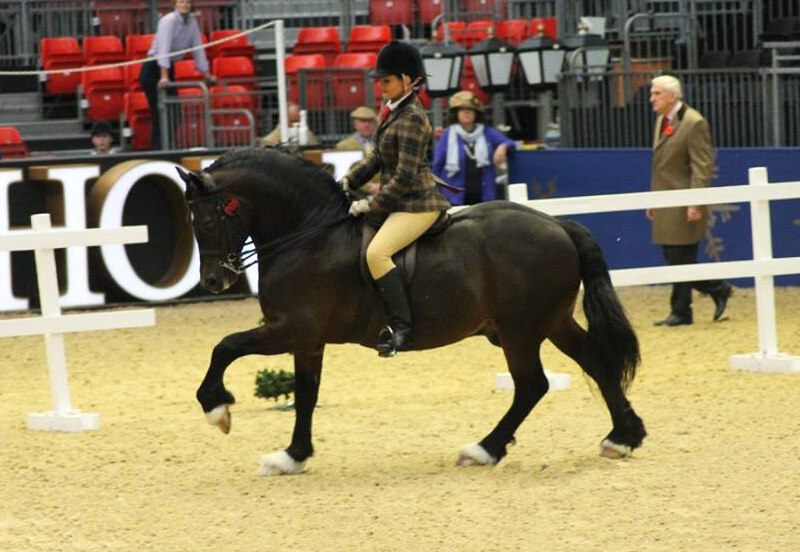
An integral part of Welsh culture, the Welsh Section D is for many the focal point of the Royal Welsh Show, and attracts some of the most passionate and loyal supporters of any breed of horse. Strong, striking, and sometimes stubborn, the fourth of the Welsh breeds is for many the most spectacular.
What is a Welsh Section D?
The Welsh Section D is the Welsh Cob, the largest of the four breeds of the Welsh Pony and Cob family. With a minimum height of 13.2hh and no upper limit, the Welsh Section D can be an imposing sight, especially a show condition stallion full of the fire of competition.
Despite its size the Welsh Section D is still expected to retain pony character, which might explain why very tall cobs are still relatively uncommon. Described by the Welsh Pony and Cob Society as “the best ride and drive animal in the world”, the Welsh Section D can be found globally, competing across many disciplines.
The Welsh Section D shares a breed standard with the Welsh Section C, although the latter has an upper height limit of 13.2hh, and the Welsh Section D must be 13.2hh or taller. The Welsh Pony and Cob Society describe the horse as “strong, hardy, an active, with as much substance as possible” and a head “full of quality and pony character, a coarse head and Roman nose are most objectionable.”
The Welsh Section D should have an “abundance of bone” and a “moderate quantity of silky feather.”
History of the Welsh Section D
The Welsh Section D has a long history, with records showing that they were used as “rounceys”- ponies that led fighting horses known as destriers- to mediaeval knights. Later they played a key role in the Welsh militia’s effort to raise Henry Tudor to the throne. During this time the breed was influenced by Arab stallions captured during the Crusades.
The Welsh Section D’s military role continued into the 20th century, with cobs being used to pull heavy equipment and guns, and the British War Office paying premiums for the best stallions.
In peace time the Welsh Section D was an important part of everyday life, being used for farm work and timbering, and as a mode of transport. Before the advent of motor cars the Welsh Section D was the fastest way for individuals to get around, and tradesmen, doctors, and other professionals would select their cob by trotting them the 35 uphill miles from Cardiff to Dowlais. The fastest cobs could do this in less than three hours.
The upper height limit of 15.2hh was removed from the breed standard in 1907, and the Welsh Cob was split into Welsh Sections C and D in 1949, creating the four Welsh breeds; the Welsh Section A, Welsh Section B, and the Sections C and D.
What Disciplines do Welsh Section Ds take Part in?
As a ride and drive animal, the Welsh Section D can be found across disciplines, although it is perhaps best known for its exploits in the show ring. The Wednesday of the Royal Welsh Show is “cob day”, when aficionados from across the world make their annual pilgrimage to watch the best of the breed compete for the Prince of Wales Cup.
Their hardiness makes the Welsh Section D a great hack and hunter, and they are particularly suited for crossing the heavy, treacherous ground of the Welsh hills. They are less common in faster and more open country, but crosses with hot bloods are well suited to these conditions.
The Welsh Section D has a brilliant action which can rack up points at dressage, but also cover ground efficiently for fun rides, trekking, and sometimes endurance riding. They can be very athletic and enjoy jumping and hunter trials.
Generally, the Welsh Section D has a gentle nature and pony character, which makes them brilliant all-round horses.
Key Characteristics of the Welsh Section D
Compared to the other Welsh Sections, the most distinctive characteristic of the Welsh Section D is its height and size. Coupled with its presence, and the manner in which these horses are presented, and the Welsh Section D in full flow can be an intimidating sight!
While it retains the pony character, the Welsh Section D is a true cob, although noticeably different to the Gypsy Cob or show cob due to its Arab-influenced head and shorter, softer feather.
In conclusion
Throughout Wales the Welsh Section D is passionately celebrated as a national icon. With its beauty, strength, and charisma, the Welsh Section D has earnt the love and admiration of generations of breeders and riders across the world, while retaining a place as a multi-talented family horse.


